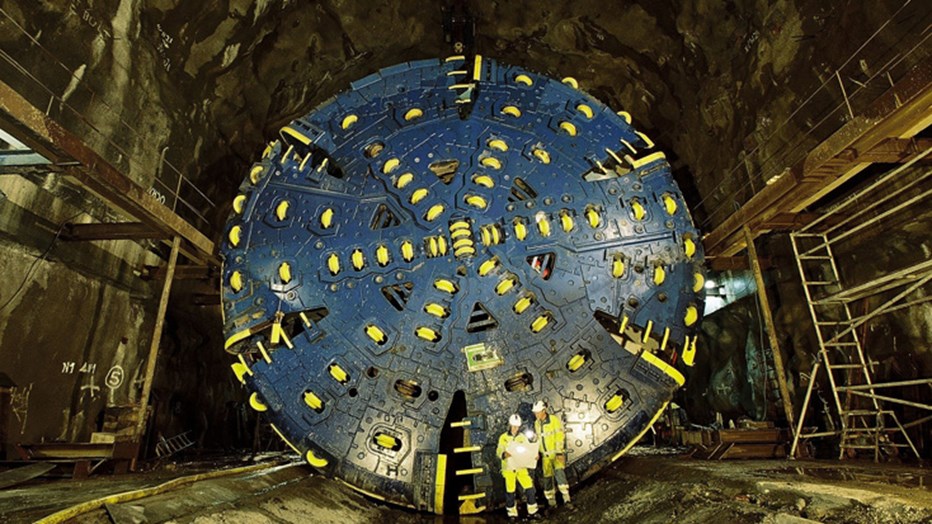Sweden’s longest rail tunnel emerges on the west coast
The Swedish Transport Administration has commissioned Skanska-Vinci to complete the construction of the tunnel through the Hallandsås Ridge, which will become Sweden’s longest rail tunnel. After 2015, when the tunnel is completed, fewer trucks and cars will travel between Gothenburg and Malmö.
The 8.7-kilometer rail tunnel will increase capacity six-fold – from four to 24 trains an hour. The current line over the Hallandsås Ridge is a bottleneck for the entire West Coast Line with its steep hills and tight curves. A rail tunnel will enable trains to travel at full speed and with a maximum cargo load.
One of the end results will be a boost for the environment. More companies can choose to transport goods by rail, which is a greener alternative than transport by truck, and more people on the west coast can commute by train to their place of work or study.
The environment is also a priority during the actual construction phase. Several systems are in place to monitor water, chemicals and the ecology of the area.
Examples of control systems:
• The volume of groundwater that leaks into the tunnel is measured throughout the day. On the section that stretches from the southern mouth of the tunnel to Lyadalen, leakage of 150 l/s is permitted during the construction phase. The permitted leakage rate is 100 l/s for the remainder of the stretch (based on an average value over 30 days). When the tunnels are completed, the permitted leakage rate has been set at 33 l/s. These are the values stipulated in the environmental permit that applies for the project.
• All water is pH-adjusted and treated before being discharged into the sea.
• All chemicals are reviewed before being approved for use.
Challenges presented by the project include the varying geological conditions of the Hallandsås ridge and the significant volumes of water contained within the feature. The Mölleback zone is a 300-meter-long section and is geologically the weakest point. The decision was taken to freeze part of the Mölleback zone to stabilize the area, thus facilitating tunneling through the section.
Skanska, which has extensive expertise of conventional tunnel construction in Sweden and previous experience of Hallandsås, is partnered by Vinci in this project in a consortium called Skanska-Vinci HB. Vinci is a French construction company with long experience of building tunnels with TBMs (Tunnel Boring Machines).
Milestones
1992 Kraftbyggarna is appointed contractor.
1996 Skanska enters as new contractor after Kraftbyggarna.
1997 The stipulations of the water permit are exceeded. Rhoca Gil is used to seal the tunnels and high levels of acrylamide are detected in the wastewater. The leakage triggers a crisis in the tunnel’s immediate environment prompting in the Swedish Transport Administration and Skanska to call a halt to the project.
1998 The tunnels are decontaminated, sealing efforts are intensified and a comprehensive environmental control process is initiated. Decision on the future of the tunnel is now the responsibility of the Swedish government. Alternatives to tunnels and various tunnel designs are examined.
2000 Tunnel sealing is completed and Skanska concludes the project. Water leakage is within the limits stipulated in the water permit.
2001 The government and the Swedish Parliament decide that the tunnel should be completed. The Swedish Transport Administration approves the construction of a municipal water network for residents of the ridge and also decides that a new procurement process should be carried out with new preconditions.
2002 The Skanska-Vinci consortium is appointed contractor for any continuation of the project.
2004 Skanska-Vinci receive the green light to resume construction of the project.
2005 Adaptation work commences on the TBMs in the autumn.
2008 The TBM, named “Åsa,” makes a breakthrough at the mid-adit. In conjunction with the subsequent maintenance stoppage, the machine’s cutter head is replaced. The machine then continues in a northerly direction.
2010 The TBM Åsa reaches a cavern in the north end of the Hallandsås Ridge, thus completing the first of the two 8.6-kilometer rail tunnels between Förslöv in the south and Båstad in the north. The machine is dismantled, with its next job to commence in February 2011 on the western tunnel through Hallandsås.
2013 A historical break through on September 4 when the tunnel-boring machine Åsa makes her final break through and finish the west tunnel.









